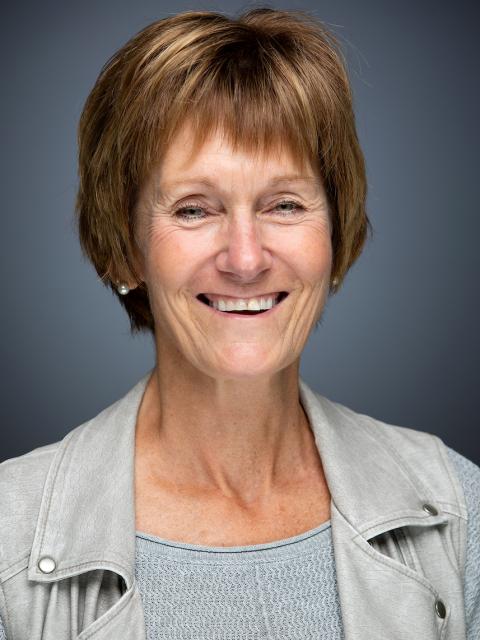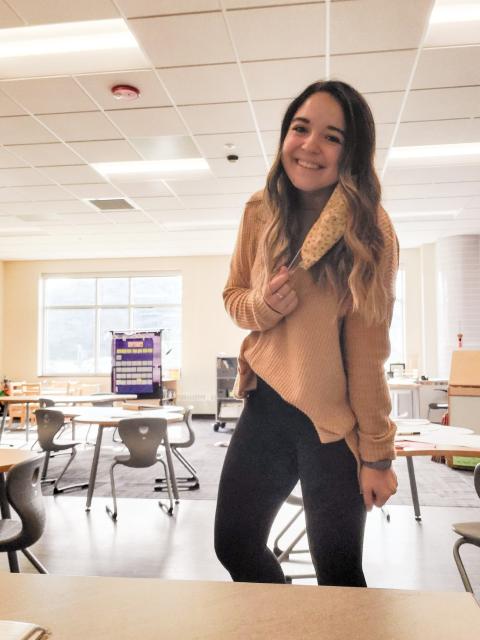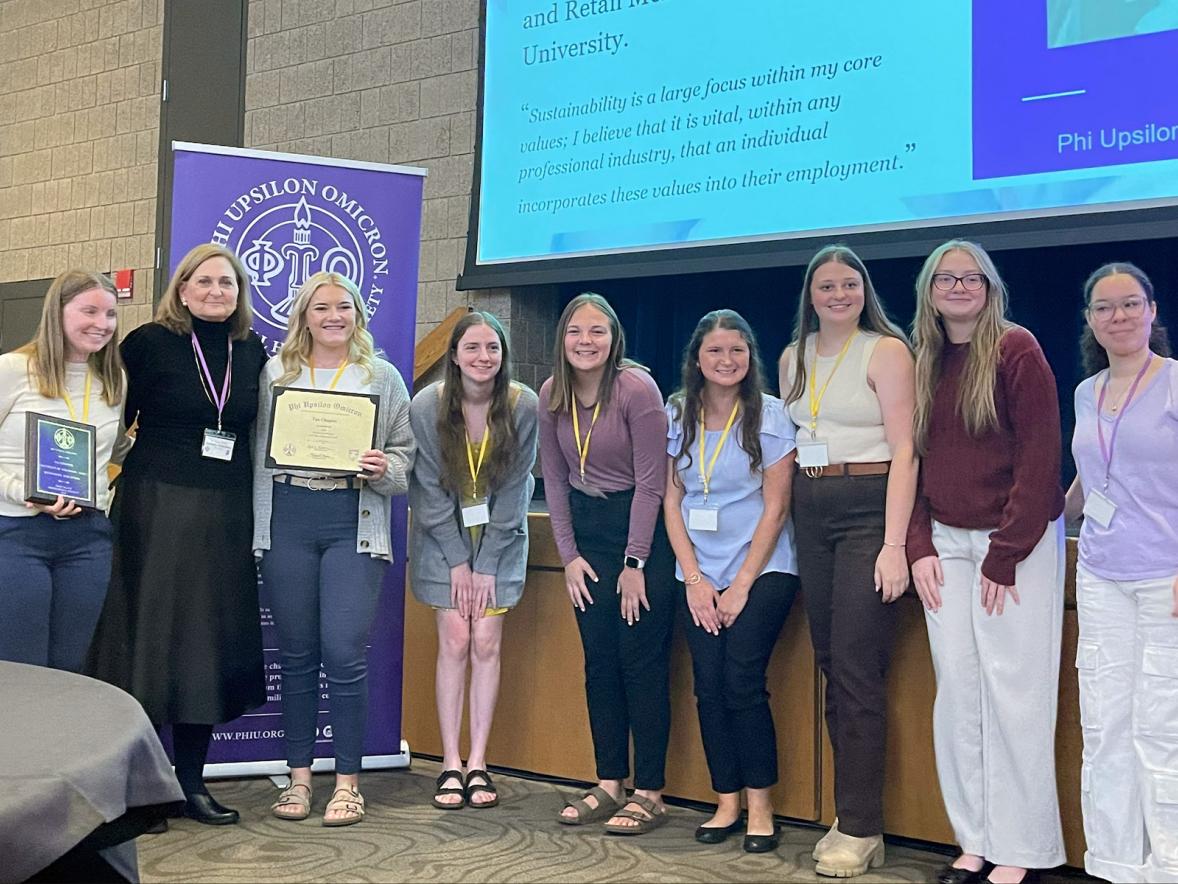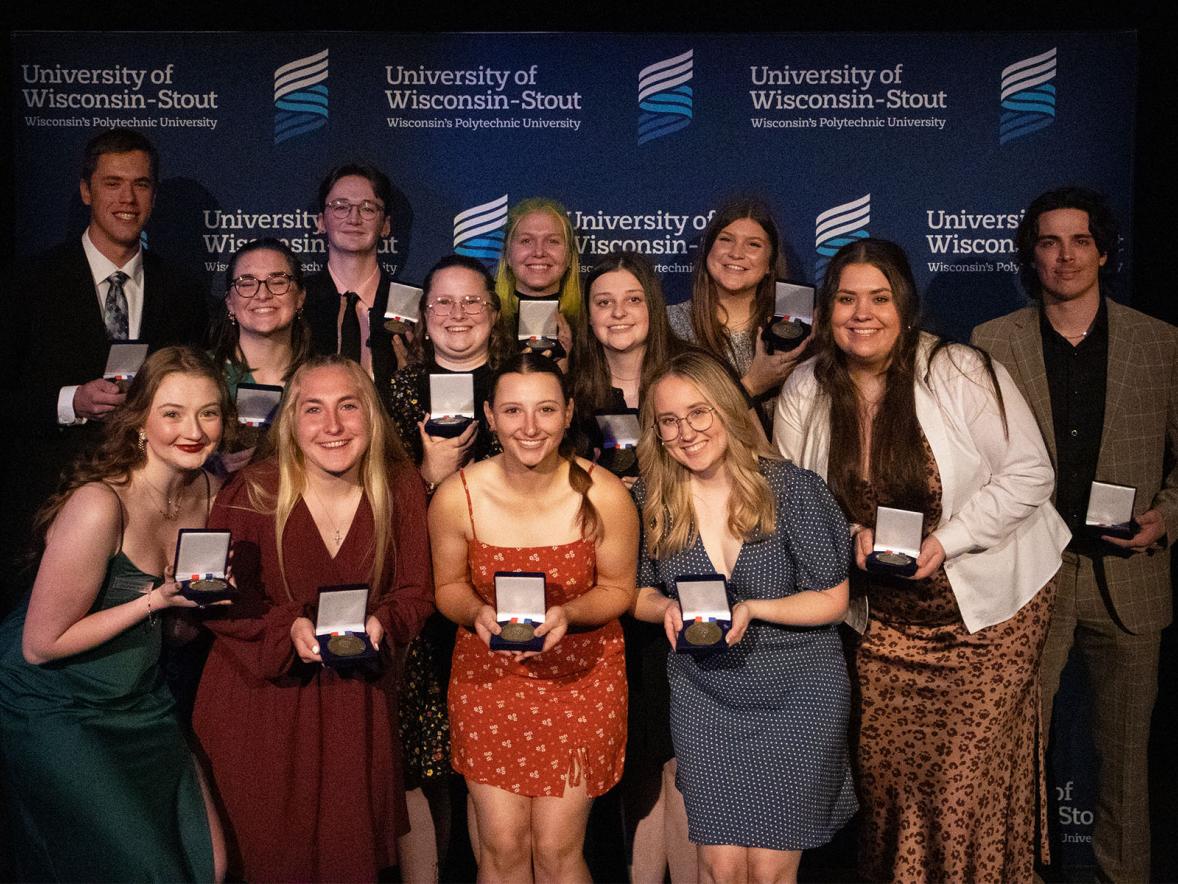University of Wisconsin-Stout early childhood education majors are applying new skills in their student teaching practices as school districts adapt learning methods and environments to safeguard students, teachers and communities during the pandemic. These measures may include restricting in-person student teacher visitations.
Tracy DeRusha, field experience coordinator in the School of Education, coordinates student teaching placements. “Every district is handling this situation in a way that works best for them, which can vary between school districts,” she said.
“We have to follow the rule of thumb for the school. We follow their safety measures, for the school and for the kids,” added Professor Jill Klefstad, supervisor of student teaching.
Three student teaching placement courses are required of ECE majors before graduation, first prestudent teaching at the preschool level followed by teaching in a kindergarten classroom and a primary classroom. The primary classroom may be in a first- through third-grade classroom.
This fall, 28 students are in their prestudent and student teaching experiences.
“Because student teacher observation requirements are in line with Wisconsin Department of Public Instruction, we have to abide by the two required visits in each placement, one of which is face to face,” Klefstad explained.
If an ECE student’s placement school is not allowing in-person visits, the supervisor may complete their observation in one of three ways:
- Virtual observations using a live or synchronous platform without recording, as some districts do not allow recording due to student privacy
- Record lessons for their cooperating teacher to present to their class, with permission from the cooperating teacher and principal
- Have the observation completed by a building administrator or teacher. This is a last resort, however.
Of the three options, the live virtual observations offer the best interaction between student teachers and their young students, without actually being there in person.

“We didn’t train our students for virtual teaching,” Klefstad said. “But as their supervisor, I say they are lucky. This is the new lay of the land.”
Klefstad hopes her students can advocate for themselves, use the new skills they’ve learned in virtual teaching in their upcoming careers and learn to be flexible and open in their virtual student teaching experiences.
“I hope students can also build a partnership with their cooperating teacher,” she said. “It’s a valuable opportunity to create a bond in a vulnerable state. It’s important for the student teacher to support the classroom teacher as they both strive to make sure the young students’ needs are put first.”
Two of Klefstad’s students, Alexa Williams and Brandon Hess, are in their final semester of student teaching. They’re adapting everything they’ve learned and finding new techniques to meet students’ needs, making meaningful connections and preparing for their careers.
Alexa Williams: Building a relationship of trust
Williams’ student teaching experience began in August in a kindergarten classroom at Ellsworth Elementary School. She feels she built a relationship of trust with her students, cooperating teacher and the school.
Now, she is in her primary placement in a first-grade classroom at Ellsworth. However, three days into her placement she needed to quarantine and is virtually teaching the school’s quarantined first-graders. The number of students varies day to day, but her class size averages six to seven students per week, she said.

“It’s a unique situation,” she said. “Teachers have to be incredibly creative and think on their toes. This is a heightened version of that. It’s an enormous challenge teaching first-graders virtually. If anyone is able to handle the ebb and flow of this situation though, it’s going to be teachers. This online experience has shown what we’re capable of.”
Because she had already established a relationship with the school, Williams was given the freedom to create her own curriculum for her virtual learners as she navigates teaching and learning online.
“To have that trust is so important to get the full experience to what it will be like when you’re on your own,” Williams said.
Williams feels she was able to make deeper connections with her kindergartners. Being there in person, she could see their needs more clearly and offer better support. Her virtual students are not as engaged because her presence is different, she said.
She connects with her virtual students, but it’s harder, she thinks. The computer screen between them acts as a wall – they see the screen and not necessarily the person on it. And having different students week to week makes building connections difficult too.
Williams sees the good and the bad of virtual learning for her students. On one hand, they’re learning hands-on technology, which they’ll use going forward. But on the other hand, there is too much responsibility behind the technology. Her first-graders must learn how to use and care for their technology properly, how to complete assignments and submit work all online.
She’d rather see the kids play. And she often feels blind to help them because she can’t see the work in front of them or see their screen to help. “I can’t see them put pencil to paper, and I can’t point to their screen if they need help finding something.”
“It’s not always fun teaching online, but it’s also something I wouldn’t trade up. It’s better than not seeing them at all,” Williams said. “And because we’re online, we don’t have to wear masks. I get to see the kids’ smiles. That’s a big perk.”
Williams always tries to learn from her students. This year, she’s learned not to take life so seriously. As a teacher, she is held responsible for so many things and there is so much expected of her, she feels. She tries to draw the line between taking care of her students and remembering to take care of herself, knowing teachers struggle with burn-out and self-doubt. She’s passed this motto on to her cooperating teachers.
“There are a million different ways to do things, and there’s not a right or wrong way,” Williams said. “If you’re doing your job with quality in mind, you’re doing it well. I try to take things slow and think how things can benefit my students and how it will affect me outside of school.”
This has been a learning journey for Williams and her first-graders. “It’s hard to know what students are going through right now. They are so young; they don’t know how to express what they’re feeling. I don’t think we’ll see the true effect until later,” she said. “But they’re so smart. We can be transparent in the best way we can in everything happening in our world, show them support and listen and let them know we’re here to help.”
Brandon Hess: Playing his role in the classroom
For his primary classroom experience, Hess student taught in-person in Scott Weber’s third-grade classroom at River Heights Elementary in Menomonie.

“I had an amazing teaching and learning experience at River Heights. Mr. Weber taught me so much about teaching techniques. He taught me how to have a fun, exciting classroom with an effective learning environment,” Hess said.
Weber, who has been teaching at the elementary level for 16 years, has hosted more than 10 student teachers from UW-Stout. Beyond becoming familiar with processes, protocol and responsibilities, Weber hopes his student teachers get a broad perspective of what it is to be a teacher.
“The beauty of River Heights is its diverse student population,” Weber said. “Whether cultural or economic, it’s so important to give students teachers perspective to the climate and social aspect of the world right now. Witnessing the diversity and needs of different students can be very eye-opening for some student teachers.”
Weber also hopes his student teachers obtain a level of comfort being a teacher. He is comfortable being silly to engage his students in lessons. Hess is more reserved, Weber said.
Hess is a self-taught guitar player, and Weber encouraged him to bring his guitar to class. Hess played and sang for the third-graders and created a writing exercise for them to express how different music made them feel.
“The kids loved the lesson and Brandon was beaming,” Weber said. “It was a highlight for me during his experience. Something clicked with him. This is what’s it’s about – making that connection in a way he felt comfortable.”
“I plan to use my talent in the future as it will be a helpful tool in the classroom,” Hess said.
Although his entire experience at River Heights was in person, Hess also held a virtual lesson from his home to show the third-graders what learning would be like if there were a school closure.
Weber thought his students did a good job and were engaged in Hess’ virtual lesson. “The challenge right now is how to meet the kids’ needs in the pandemic,” Weber said. “I can’t imagine what it’s like for student teachers because even veteran teachers are having difficulty. Teachers and student teachers can work it out together. It’s all new territory.”
Hess agreed. “It’s a new time. Being online, you do not have those student interactions or great class discussions you would have in person. But the virtual experience can be beneficial because it prepares me and my students for learning new techniques. I think having these new techniques is a great thing to have in the upcoming years.”
Hess is student teaching kindergartners in person at Ellsworth, helping with math, science, reading and handwriting. “It has been a great start the last couple of weeks, and I will continue to grow and learn as I am teaching the young kiddos,” he said.
Finding their niche in teaching
In high school, Williams worked at a gymnastics center in her hometown of Red Wing, Minn. She has a passion for the sport and was happiest with the kids. So, although Williams originally wanted to study engineering, she realized she didn’t know what she would do if she couldn’t work with kids.
“I heard that Stout had the best education program, and without even taking a tour I jumped all in,” she said.
Hess, of Rhinelander, chose ECE for similar reasons. He has always been around children. “I remember helping them and feeling good after teaching them a new skill and working on it with them. I enjoy the positivity that comes with teaching,” he said.
Williams and Hess graduate this December. Hess hopes to find a subbing or teaching opportunity in a third-grade classroom.
Williams has a concentration in special education and has accepted a position as an early special education teacher at Colvill Family Center in Red Wing, the same preschool she attended as a child.
“I feel this is truly where my niche is,” she said. “Everything came full circle.”







